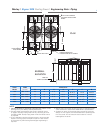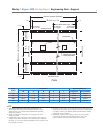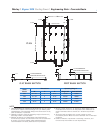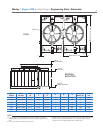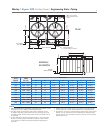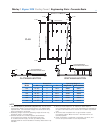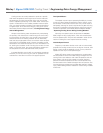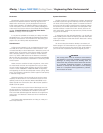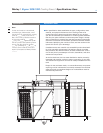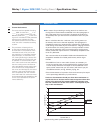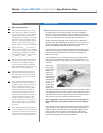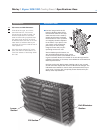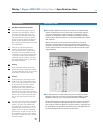
Marley
/
Sigma 1000/1200 Cooling Tower
/
Engineering Data: Environmental
13
Enclosures
Occasionally, cooling towers are located inside architectural
enclosures for aesthetic reasons. Although Sigma towers
adapt well to enclosures, a poorly designed enclosure can
impair proper operation. An effective design includes gener-
ous air inlet paths, with the tower’s fan cylinder discharge at
or above the top of the enclosure. See Marley Technical Report
#H-004, “External Influences on Cooling Tower Perfor-
mance”, for design recommendations.
It may also be advisable to increase your design wet-bulb
temperature by 1°F to compensate for potential recirculation
initiated by the enclosure. You’ll benefit from discussing your
project with your Marley sales representative.
Sound Control
A Sigma tower operating in an unobstructed environment
will meet all but the most restrictive noise limitations – and
will react favorably to natural attenuation. Where the tower will
operate within an enclosure, the enclosure itself will usually
have a damping effect on sound. Distance will also reduce
sound – by about 5 dBA each time the distance is doubled.
Where noise at a critical point is likely to exceed an acceptable
limit, you have several options, listed below in ascending order
of cost impact:
Noise concerns are often limited to nighttime, when ambi-
ent noise levels are lower and neighbors are trying to sleep.
You can usually resolve these situations by using two-speed
motors in either 1800/900 or 1800/1200 RPM configuration;
and operating the fans at reduced speed without cycling “after
hours”. This relatively inexpensive solution pays for itself quickly
in reduced energy costs.
Where the problem can exist at all times (such as near a
hospital), the best solution is to oversize the tower so it can
operate continuously at reduced (1200 or 900 RPM) motor
speed. Typical sound reductions are 7 dB at 2/3 fan speed or
10 dB at 1/2 fan speed.
Extreme cases may require inlet and discharge sound at-
tenuator sections; however, the static pressure loss imposed
by attenuators may necessitate an increase in tower size.
This is the least desirable approach because of its significant
cost impact – and because it obstructs normal maintenance
procedures.
Your Marley sales representative can help you meet your
sound requirements.
System Cleanliness
Cooling towers are very effective air washers. Atmospheric
dust able to pass through the relatively small louver openings
will enter the circulating water system. Increased concentra-
tions can intensify system maintenance by clogging screens
and strainers; and smaller particulates can coat system heat
transfer surfaces. In areas of low flow velocity (such as the
cold water basin), sedimentary deposits can provide a breed-
ing ground for bacteria.
In areas prone to dust and sedimentation, you should con-
sider installing some means for keeping the cold water basin
clean. Typical devices include side stream filters and a variety
of filtration media.
You should also plan ahead to develop a consistent, ef-
fective program of water treatment. A good water treatment
program will help to assure long service life, while keeping
your tower free of potentially harmful biological growths.
CAUTION
The cooling tower must be located at such distance
and direction to avoid the possibility of contaminated
discharge air being drawn into building fresh air
intake ducts. The purchaser should obtain the services
of a Licensed professional Engineer or Registered
Architect to certify that the location of the cooling
tower is in compliance with applicable air pollution,
fire and clean air codes.



